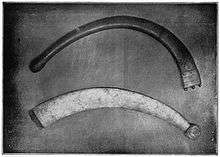Valari
| Valari | |
|---|---|
 | |
| Type | Throwing Stick |
| Place of origin | India |
A valari (Tamil: வளரி) or valai tadi is a throwing stick used primarily by the Tamil people of India and Sri Lanka.[1] Valari were used in war, fighting, and hunting. It was the favorite weapon of choice in a deer hunt.
Shape
Like the boomerang of the aboriginal Australians, the Tamilian valari doesn't return to the thrower. Valari were made in many shapes and sizes. Marudhu Brothers, brave Tamil kings were the veteran of using this. The usual form consists of two limbs set at an angle. One is thin and tappering while the other is rounded. The rounded end was used as a handle. They were usually made of wood or iron. Other valari had wooden limbs tipped with iron. Some had limbs which had lethally sharpened edges. Special daggers known as kattari, double-edged and razor sharp, were attached to some valari.
Use
The thrower holds the valari by one of its limbs and throws it. There are several ways of throwing and aiming. It is usually given a spin while throwing. While flying through the air, it maneuvers and executes several types of movements according to the throwers purpose. It may spin in the vertical axis, horizontal axis, or just fly without spinning. The spin may also vary in speed. A lethal throw is given a spin and aimed at the neck. A non-lethal throw is given a spin and aimed at the ankles or knees. This is to capture a fleeing victim. A simple hurting blow does not have any spin.
References
- ↑ Thurston, Edgar (2001) [First printed in 1909 by Madras Government Press]. "Kallan". Castes and Tribes of Southern India III (Fourth AES reprint ed.). New Delhi: J. Jetley. p. 70. ISBN 978-81-206-0288-5. Retrieved 8 January 2013.